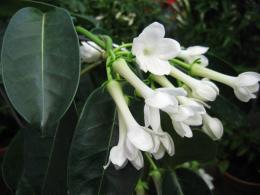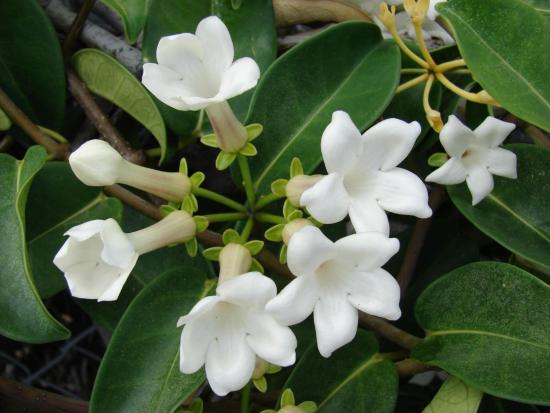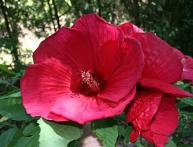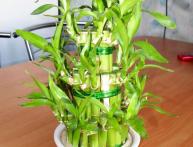Indoor stephanotis flower: propagation and growing rules

Many beautiful flowers came into indoor floriculture from wild tropical nature. When certain conditions are created, representatives of tropical flora grow well indoors. The stephanotis flower is no exception. reproduction and the cultivation of which as a potted crop is very successful.
Content:
- Stephanotis, botanical description
- Features of growing and propagating stephanotis at home
- Reproduction of Madagascar jasmine
Stephanotis, botanical description
The genus Stephanotis from the family Lastoneaceae is represented by several species. Some botanists attribute almost two hundred tropical vines to this genus, others believe that there are no more than 16. The plant was first discovered and described at the beginning of the 19th century. The range of stephanotis covers about. Madagascar, Malay Islands and other tropical territories.
In indoor floriculture, you can most often find Stephanotis profusely blooming or Stephanotis floribunda. This plant is also called:
- wedding wreath
- Hawaiian wedding flower
- wax flower
- Madagascan jasmine
Under natural conditions, the life form of this plant is an evergreen vine entwining trees; shrubby forms can also be found. The length of the shoots can be from 2 to 6 meters. The leaves of the plant are oval in shape, with a rounded base and a narrower apex.

The edges of the leaf plates are solid, they themselves are dense with a glossy sheen, up to 8 cm long.The location on the shoots is opposite. The flowers are white, sometimes cream or pinkish, tubular, tube length 30 mm, with five bent corolla petals. Collected in inflorescences - false umbrellas or scutes.
They emit a very pleasant aroma and give the impression of ideal wax products. The flowering period begins closer to mid-spring and continues until early autumn. The fruit is a berry, looks like a mango, takes a long time to ripen, almost 9 months. Contains up to 100 pieces inside. thin seeds equipped with soft hairs that form a kind of parachute.
Madagascar jasmine is widely used as an interior plant and is grown in residential premises, offices, and greenhouses. Its shoots can be beautifully fixed on an arc made of a flexible rod or wire. When the plant blooms, its shoots, covered with flowers, in this case, will look like a wreath.
Features of growing and propagating stephanotis at home
At home The plant is placed in a well-lit place, but protected from direct sun. In summer, the room temperature should be +20 +22 degrees. In winter, it needs to be reduced to + 14 + 16 degrees, without this the plant may not gain color. Water for irrigation must be left to stand for 48 hours.
During the growing season, watering is done on average every two days, and in winter - once every seven days. In addition to watering, the plant is fed once every half month. At the beginning of spring, you can use a full mineral fertilizer, and during the period of budding and flowering, fertilizing is carried out with fertilizers without nitrogen. The plant needs additional spraying of the indoor air.
To give it a more well-groomed appearance, the upper side of the leaves is polished.The easiest way is to polish with a soft cloth soaked in water. However, you can also use special aerosols. They have antistatic properties and the foliage attracts less dust. Important! The plant does not like not only a change of location, but also a change of orientation in the room.
Video review of the stephanotis flower:
Throughout the season, the ends of the shoots need to be pinched. It is advisable to replant the plant in the spring, and after flowering has finished, it can be pruned. Stephanotis is propagated at home:
- seeds
- cuttings
- leaf
Best time for reproduction flowering occurs in early spring.
Reproduction of Madagascar jasmine
Growing from seeds
The seeds of the plant can be obtained from a ripened fruit if it was formed at home. Seeds can be bought in a specialty store or online. A small bowl is filled with a mixture of peat and perlite and watered well. The seeds are laid out on top of the soil; they are not embedded in the soil, but only lightly pressed against it.
Cover with film. They put it in a room where there is good lighting and quite warm, at least + 25 + 26 degrees.
During the entire period, the soil must not only be moistened, but also the crops must be ventilated. After 4-8 weeks, the seeds germinate. For the first three days they are kept under film, then it is removed. In the future, the seedlings are regularly moistened and additional lighting is provided. Daylight hours at this time should be at least 14 hours.
Propagation by cuttings
Cuttings Stephanopis is cut only from last year's shoots. They should be about 10 cm long and each cutting should have a pair of leaves. There should be 3-4 cm left under the bottom sheet. The bottom cut is made obliquely. The top sheet is shortened by half and the cut area is sprinkled with coal.The cuttings can be placed in warm water and changed every two days. Usually, after one and a half to two months, roots appear, with which the plant can be planted in a pot.
In addition to water, you can root the cuttings in a mixture of universal soil and perlite. The lower end is buried 1.5 cm, everything is well moistened and the cuttings are kept in a warm and bright room. The roots also appear after 7-8 weeks. After this, the cuttings are planted in individual pots. Then keep it warm. The pot is kept covered with a transparent bag for some time.
Leaf propagation

This method is also used by flower growers; you can try to get a young plant from one leaf with part of a shoot. To do this, you will need to take a zip bag (bag with a lock), pour a mixture of soil and perlite into it, spray it well, put the leaf so that the stalk with part escape touched the mixture. Hang the package on the east window and wait for the roots to appear. They will be clearly visible through the transparent bag.
In this case, the process of root emergence will take about one and a half months. Stephanotis is considered a plant that is difficult to take root, however, if this procedure is carried out at a constant temperature and proper lighting, then, as a rule, the process ends in success.










